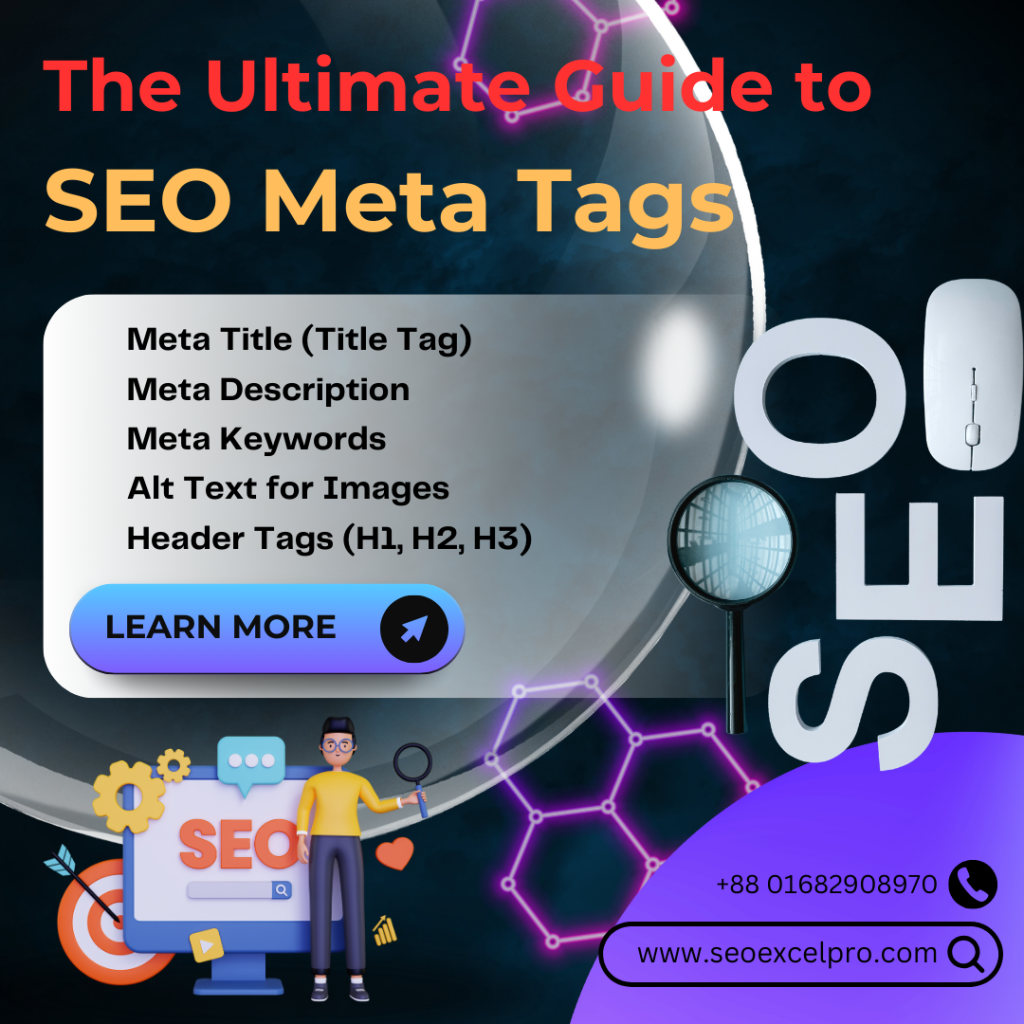In the world of SEO services, meta tags play a crucial role in improving your website’s visibility and performance on search engines. These small snippets of text, which are embedded in your website’s code, help search engines understand the content of your pages and can directly influence how well your site ranks. In this guide, we’ll walk you through the importance of SEO meta tags and how to optimize them for better rankings.
As an SEO expert, optimizing meta tags is one of the first steps I take to ensure improved SEO performance for my clients.



What Are SEO Meta Tags?
Meta tags are HTML elements that provide information about your web pages to search engines and website visitors. They are not visible on the page itself but appear in the page’s source code. The primary goal of meta tags is to improve your site’s SEO performance by making it easier for search engines like Google to understand what each page is about.
The most important meta tags include the meta title, meta description, and meta keywords. Let’s dive into each of these.
1. Meta Title (Title Tag)
The meta title is one of the most critical SEO meta tags for improving rankings. It’s the clickable headline that appears in search engine results and tells both search engines and users what the page is about.
Best Practices:
- Keep it under 60 characters to ensure it doesn’t get cut off in search results.
- Include your primary keyword close to the beginning.
- Make it engaging and relevant to encourage click-throughs.
Example: For a blog post on SEO services, a good title tag could be:
“SEO Services for Small Businesses: Boost Your Online Visibility”
2. Meta Description
The meta description is the short summary that appears below the meta title in search results. Although it doesn’t directly impact rankings, a well-written description can significantly increase your click-through rate, which indirectly benefits your SEO campaigns.
Best Practices:
- Keep it between 150-160 characters.
- Include your primary and secondary keywords naturally.
- Make it compelling to encourage users to click.
Example: “Looking for affordable SEO services to grow your online presence? Discover how our SEO specialists can help boost your rankings and drive traffic.”
3. Meta Keywords (Less Important Today)
In the early days of SEO, meta keywords were widely used to indicate the target keywords for a web page. However, search engines like Google no longer rely on meta keywords for rankings due to misuse and keyword stuffing. Despite this, some still opt to include them as a reference for other search engines or platforms.
Best Practices:
- Include a few relevant keywords, but don’t overdo it.
- Focus more on the quality of your content and the optimization of other SEO meta tags.
4. Alt Text for Images (Bonus)
While not a meta tag, alt text for images is an important SEO element. It helps search engines understand the content of your images and improves your chances of appearing in image search results.
Best Practices:
- Use descriptive text that explains the image.
- Include keywords where appropriate.
Example: For an image on a page about SEO expert services, you might use:
“SEO specialist optimizing a website for better search rankings.”
5. Header Tags (H1, H2, H3)
Header tags structure your content and make it easier for both users and search engines to navigate your page. While they aren’t technically meta tags, H1 and other header tags help with on-page SEO.
Best Practices:
- Use your primary keyword in the H1 tag (main headline).
- Use H2 and H3 tags to break up your content and include secondary keywords naturally.
Why SEO Meta Tags Matter
Optimizing your meta tags is a small yet impactful step in improving your website’s SEO performance. Well-crafted meta titles and descriptions not only help search engines understand your content but also make your pages more appealing to potential visitors.
By taking the time to optimize your SEO meta tags, you can:
- Improve your click-through rate (CTR).
- Increase visibility in search results.
- Enhance the user experience by providing clear, concise information.
How to Optimize Your Meta Tags for SEO
To get the best results from your SEO campaigns, follow these tips:
- Do keyword research: Understand what keywords your audience is searching for and include them in your meta titles and descriptions.
- Be concise but descriptive: Ensure your meta titles and descriptions accurately reflect the content on the page without exceeding character limits.
- Avoid keyword stuffing: Focus on creating meta tags that are natural and readable. Google favors content that is user-focused.
- Update regularly: As your content evolves, make sure to update your meta tags to reflect any changes or new keyword strategies.
Conclusion
SEO meta tags are a foundational part of any successful SEO strategy. While they may seem small, they have a big impact on how search engines understand your content and how users engage with your site in search results. By optimizing your meta tags, you can boost your site’s visibility and performance in search engines.
Whether you’re just starting out or looking to improve your existing SEO efforts, optimizing your meta tags is an easy win that can deliver real results. For professional help with your meta tags and overall SEO strategy, contact an SEO specialist at SeoExcelPro today!

2 Responses
helpful content
Thanks